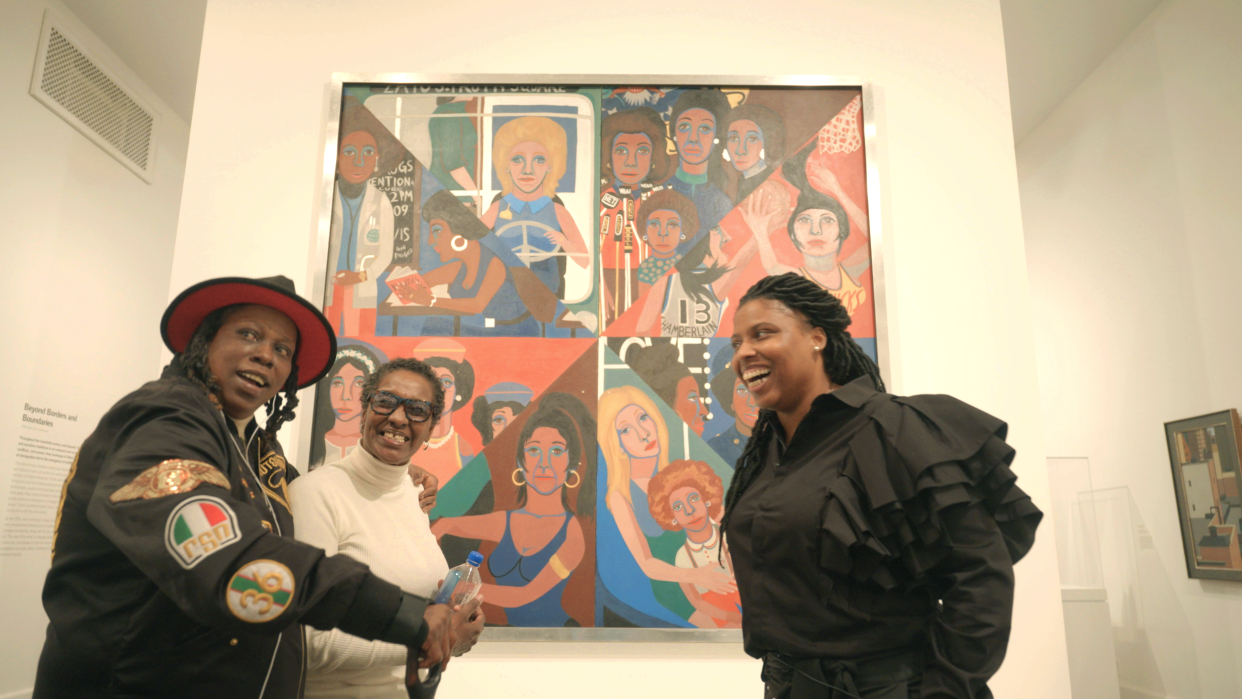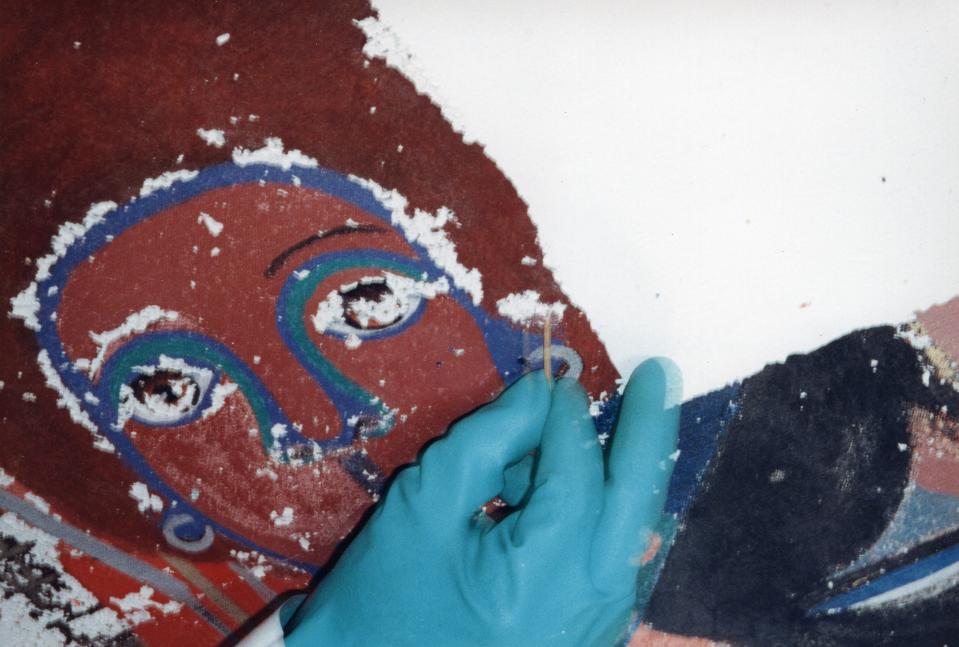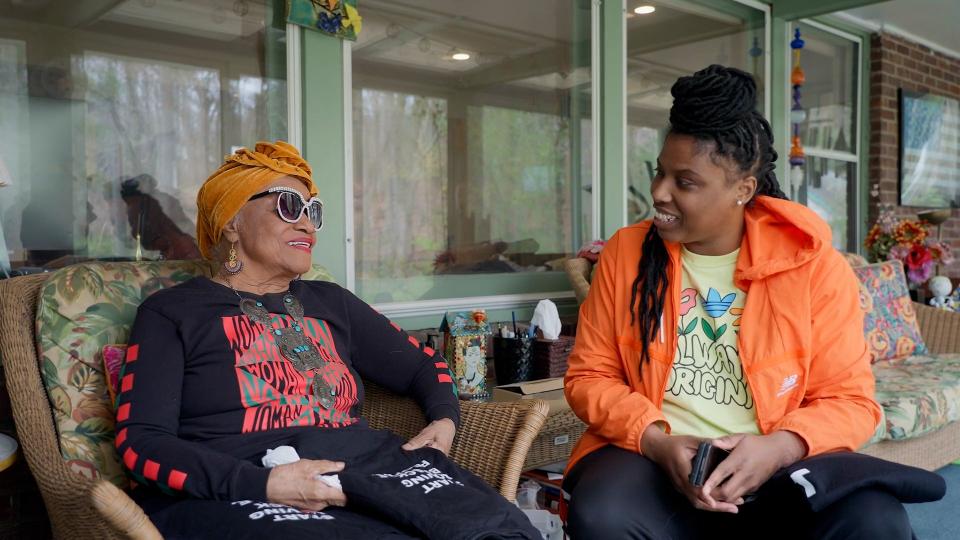A Rikers Island Painting Goes on a Powerful Journey in New Documentary Paint Me a Road Out of Here

Courtesy of Aubin Pictures
On a spring afternoon in Englewood, New Jersey, nearly one year to the date before her passing this past April, renowned painter, quilter, writer, and activist Faith Ringgold was sitting on her porch. Printed proudly in the center of her black, long-sleeve t-shirt was a miniature version of her painting Woman Freedom Now, made in 1971. “I have no idea what’s going on in prisons today,” she told fellow mixed-media artist and scholar Mary Enoch Elizabeth Baxter. Baxter responded, “It’s one of the most violent places you can be.”
52 years before this conversation took place, Ringgold had been commissioned by the New York State Council on the Arts’ Creative Arts Public Service Grant to make a piece for a public institution in the city. She chose the Women's House of Detention on Rikers Island and, that same year, paid a visit to the women incarcerated there. “What would you like to see in this painting?" she asked. From the back of the group, Ringgold remembered a young girl speaking up: "I wanna see a road leading out of here." The result was an 8x8 foot oil on canvas painting portraying women in professions that, at the time, were mostly not available to women — professional athletes, doctors, ministers, presidents. Eponymously named For the Women’s House, the painting was meant to evoke freedom in a place devoid of just that. After its installation in 1972, the painting remained until, 20 years later, it went missing.
The ensuing story of the painting’s confinement on Rikers is at the crux of a new film, Paint Me a Road Out of Here, by director and activist Catherine Gund under her production company Aubin Pictures; Yara Shahidi and her mother Keri joined the documentary as executive producers alongside Baxter and other artists like Mickalene Thomas and Julie Mehretu. The documentary premiered June 14 at the National Museum of African American History & Culture in D.C.
The film tackles the relationship between art and institutions like the museum and the criminal legal system by way of Ringgold, For the Women’s House, and Baxter, the aforementioned artist whose research, music, and artwork is an extension of her experience with incarceration. The two artists’ conversation on Ringgold’s porch described above is one prominent scene in the film. But in the one and a half hour watch, perhaps most poignant is the consistent parallel drawn between the treatment of Ringgold’s work while on Rikers with that of the women held inside the facility.
In 1988, Prison Policy Initiative estimates that 30,299 women were being held in jails across the United States, a number that has since tripled. (To this day, the majority of people held in local jails have yet to be convicted, but, unable to afford bail, remain inside). In that same year, the 800 or so women initially held at the Women’s House on Rikers were moved to a new building, Rose M. Singer (also called “Rosie’s”). Ringgold’s painting, however, did not follow them. Neither did Barbara Drummond, a correctional officer at the time who, eventually, noticed that the canvas had been taken down.
Familiar with Ringgold’s artwork from her time volunteering at the Schomburg Center for Research in Black Culture, Drummond would often look at the painting after roll call, admiring the texts by Coretta Scott King or Rosa Parks and Ringgold’s visions of what she describes as “everyday working people.” “She was a true American artist that told a great story [of] how we grew up, how Black people grew up,” Drummond shared with Teen Vogue this past month in Brooklyn. After asking fellow officers and even the deputy warden to no avail, Drummond began roaming the facility in search of the painting and eventually spotted a bright white object protruding from a wall in the staff kitchen. For the Women’s House had been completely painted over in white, water-based paint. Soon after, she submitted an intradepartmental memo — the subject, “Destruction of Artwork” — to Warden Robert Brennan.
If not for Drummond, the painting — at the time worth a few million dollars — would likely have been forgotten and destroyed. Her discovery, however, began a years-long fight to repair and rescue the piece. What ensued over the next four years was a continuous back-and-forth between the Historic Preservation Office, Ringgold, the jail, and others that ended in a reinstallation of a restored painting in the women’s gym, caged in plexiglass, well above eyeline (much to the dismay of Ringgold).

It was a Wednesday in December 2021, 21 years since the reinstallation in February 2000, when Catherine Gund first heard snippets of this story. She was on a tour of Rikers with members of Art For Justice, the six year spend-down fund she started with her mother, Agnes Gund, to support artworks and organizations dedicated to ending mass incarceration. Since the gym installation all those years ago, the painting had journeyed out of the jail temporarily for two exhibitions, one of which was a 2017 show at the Brooklyn Museum. When returned, it hung in an empty hallway that incarcerated women rarely passed by. If they did, they were certainly never given the space and time to actually look at it. “Nothing in jail is supposed to excite your soul,” Enid “Fay” Owens, an advocate featured in Paint Me A Road who also spent time incarcerated at Rose M. Singer, shares with Teen Vogue. “It ain’t about rehabilitation, and anything that looks like it might be something that can educate and empower, they are taking that.”
Gund saw in this story a clear metaphor: a beautiful painting went into Rikers and came out destroyed. The same goes for the countless individuals who end up on Rikers, 90% of whom are being held pre-trial.
So, in addition to documenting the history of Ringgold’s resistance through art, Gund had the thought that Art for Justice could realize the artist’s wish of getting this painting out and commission a new, updated piece for women inside. That’s when Baxter entered the conversation. At the time, Baxter was working on a collaborative mural and curriculum based on what she tells Teen Vogue is the “the power of personal affirmations” with women incarcerated in Philadelphia, her hometown. Having been incarcerated herself, Baxter was intimately familiar with the way women are warehoused and oppressed inside carceral facilities.
“When you go on the inside, you’re labeled, you’re rubber stamped with all of these negative connotations about who you are or what you represent,” Baxter says in the film. “Artmaking was my outlet and my channel to reimagine my own self outside of incarceration.” While building on the idea of a prospective piece by Baxter in the jail, the documentary also follows Baxter through her day to day, from a move that unearths personal archives to her 2023 exhibit Ain’t I a Woman at the Brooklyn Museum, which explores themes of adultification bias and her own experience shackled while giving birth incarcerated.
By interweaving Baxter’s and Ringgold’s stories, Paint Me a Road not only highlights the role art plays in historical movements like that of civil rights and prison abolition, but it also underscores the intimate connection between carceral facilities and museums. Just as Ringgold protests the
Whitney for excluding Black artists in its exhibitions, for instance, Baxter uses her art to hold the criminal legal system accountable in its targeting of Black women.
“Prisons and museums emerged from the same type of ideology in the early 19th century as part of the building of civic and governmental institutions to teach [people] how to behave,” says Nicole Fleetwood, an academic and curator most known for her project Marking Time: Art in the Age of Mass Incarceration. She goes on in the documentary to describe how museums were a space where people could “aspire to ‘high culture’” while prisons were meant to house those who did not “follow that trajectory.” “They are institutions that teach the public what to value and devalue,” she says, adding that “Black people were held captive in one institution and excluded from the other.”

After a year of putting projects on hold only for her commissioned project to be continuously pushed back, Baxter did not move forward with an artwork collaboration inside Rikers. “I also started to analyze all the ways in which this project…would just be recreating some of the same scenarios that Faith Ringgold did not want to be involved in,” Baxter tells Teen Vogue. Conversely, For the Women’s House eventually made it out of Rikers, and is on loan to the Brooklyn Museum to this day. Gund says the process of “freeing” the painting is akin to what is required when envisioning a world without prisons or jails. “The fate of the painting is tied to the fate of the women, and vice versa,” she tells Teen Vogue, outlining five pillars that connect the two: accountability, value, community, urgency, and a plan.
The first two pillars, according to Gund, reiterate care as crucial to the parallel processes. Rehoming the painting was a decision that came from a collective understanding how and why the painting was mistreated inside Rikers and mending that harm with better care at the Brooklyn Museum. Within the criminal legal system, this type of accountability means recognizing why harm occurs and moving toward a solution of repair rather than punishment. (Between 45% and 93% of women and gender-expansive people that go through Rikers have experienced domestic and/or sexual violence; 80% have mental health issues; and 25% of women at jail intake report having been homeless before being jailed). The painting’s value shifted the jail’s efforts to treat it with care, as it was no longer a disposable canvas. If society better validated the humanity of the 2 million individuals currently behind bars in the United States — better understood the communities and passions they’re often forced to leave behind — we might become uncomfortable with the use of shackles and handcuffs, food devoid of nutrition, buildings lacking natural light, separation from families, and so on.
The three latter pillars are the mechanisms that realize a freed painting or freed people. In the same way the painting required a community of folks to leave Rikers — among them the Mayor’s office, the commissioner of NYC’s Department of Corrections, the museum staff, Ringgold, and Art for Justice — getting people out of Rikers requires this same collective buy-in, Gund says.
When this conglomerate worked together to move For the Women’s House in late 2021, Vincent Schiraldi had only two weeks left as commissioner, applying urgency for all parties. “If we said, ‘you've got one year to get all of the women out of Rosie’s, that would be an entirely different degree of motivation,’” Gund tells Teen Vogue. And lastly, moving the painting meant a succinct plan. “The Brooklyn Museum had previously demonstrated a commitment to the painting,” Gund adds, citing the previous exhibit and the fact that Faith ultimately wanted it to remain there in 2017. Having a clear map of next steps when moving the painting helped get people on board. Similarly, it’s necessary to spell out what providing community-based programs for people would look like — a combination of trauma-informed programing and therapy, safe housing, gainful employment, etc — rather than incarcerating them.
The intertwined fates of For the Women’s House and the women still incarcerated on Rikers is still to be determined. On loan for 10 years at the Brooklyn Museum, the painting’s future rests in the hands of the city; it could be returned to Ringgold’s estate or perhaps sold to the museum, though it’s unclear. And while there are plans for Rikers to close in 2027, Mayor Adams’ recent announcement to invest $225 million in its own version of a “cop city” does not indicate a future that invests in community care over punishment.
But for now, the painting is accessible to the public as a reminder of the many women who experience the criminal legal system. For Leah Faria, the Director of Community Liaisons and Task Force with the Women’s Community Justice Association (WCJA) this fact is crucial. “The public can see it and know that the women behind the wall had a voice, that they existed,” she says while looking at the painting in the museum in one of the documentary's last scenes.
As a key leader in the field of advocacy, particularly when it comes to raising awareness around diversion programs for women detained on Rikers, WCJA has been a partner of Paint Me A Road since the onset of the film. Together, Gund and her team will continue to invest in the visions led by WCJA. “We need to heal the community, not harm them anymore, not perpetuate anymore violence,” WCJA’s Executive Director, Sharon White-Harrigan, tells Teen Vogue. “There is justice beyond punishment.”
Originally Appeared on Teen Vogue
Want more great Culture stories from Teen Vogue? Check these out:
A New Generation of Pretty Little Liars Takes on the Horrors of Being a Teenage Girl
Underneath Chappell Roan’s Hannah Montana Wig? A Pop Star for the Ages
Donald Glover’s Swarm Is Another Piece of Fandom Media That Dehumanizes Black Women
On Velma, Mindy Kaling, and Whether Brown Girls Can Ever Like Ourselves on TV
Gaten Matarazzo Talks Spoilers, Dustin Henderson, and Growing Up on Stranger Things
How K-pop Stars Are Leading Mental Health Conversations for AAPI People and Beyond
Meet the Collective of Philly TikTokers Making You Shake Your Hips
The Midnight Club Star Ruth Codd Isn’t Defined By Her Disability


